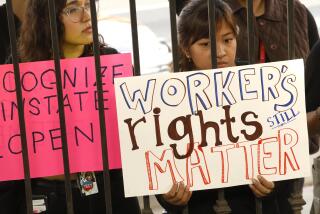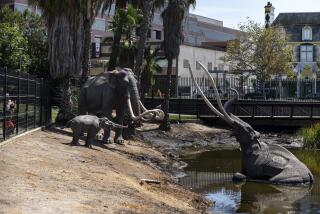Air and Space and gift shop
- Share via
WASHINGTON — Spring is a beautiful thing for those who run the Smithsonian Institution. School breaks and cherry blossoms mean tourists -- and their money.
“This is prime time for us now,” Smithsonian spokeswoman Linda St. Thomas says. “You can see the out-of-town buses lined up on Jefferson Drive from the Castle all the way to the American Indian Museum.”
All those kids pouring into the museums are important to the Smithsonian because the Mall is increasingly becoming a mall.
Although admission is still free, sales of movie tickets, food and trinkets are soaring. Last year such marketing ventures grossed $156.3 million, returning $26.7 million in profit to the museums -- nearly half the Smithsonian’s unrestricted funds, to be spent any way it pleases.
Marketing has become so important that the Smithsonian now knows from surveys that the kids in the school groups that fly through the National Air and Space Museum each have about $5 to $10, and just about that many minutes to spend it.
That’s why the gift shop at the world’s most visited museum is stocked with budget-friendly items such as military dog tags and marbles designed to look like planets, and why 200,000 packs of freeze-dried astronaut ice cream were sold last year.
There is now a McDonald’s at Air and Space, and a Subway sandwich shop at the National Museum of American History. The two Imax theaters on the Mall have signs that list each other’s show times, so visitors can conveniently arrange their schedules accordingly.
Then there is the shopping.
Of the six shops in the National Museum of Natural History, some are directly connected to permanent exhibitions while others are open for the duration of a particular show. One currently sells botanical prints, mugs, magnets and silk flowers for an orchids exhibit, and the main store has set up a large case with pearl items for a new show on pearls.
The new National Museum of the American Indian has two prominently located stores, where a recent visitor bought a $55,000 sculpture by Allan Houser, and its food court features regional dishes from areas with Native American populations.
All methods of sending visitors home with loaded shopping bags are being tested, a common phenomenon in modern museums, which are giving visitors what they demand: a one-stop experience with restaurants and shopping. New York’s new Museum of Modern Art has three restaurants and two stores; the Louvre has eight restaurants and cafes, plus shops for its reproductions and books.
The Smithsonian always had the potential of high-volume shopping and eating: Its museums had 20 million visitors last year; 220,000 people shopped its catalog; 62,000 made purchases online; and its 18 museums all have different personalities.
But it wasn’t until 1999 that the Smithsonian placed all its profit sectors within the division Smithsonian Business Ventures. It now provides almost half of the $50 million to $60 million in the Smithsonian’s unrestricted account, which can be directed anywhere. The rest comes from interest income and private contributions.
“The 2004 figures showed sales from museum businesses and concessions have recovered to the level before 9/11,” division CEO Gary Beer says. Last month, the Smithsonian museums saw a 64% increase in visitors from the previous March.
More to Read
Sign up for The Wild
We’ll help you find the best places to hike, bike and run, as well as the perfect silent spots for meditation and yoga.
You may occasionally receive promotional content from the Los Angeles Times.






